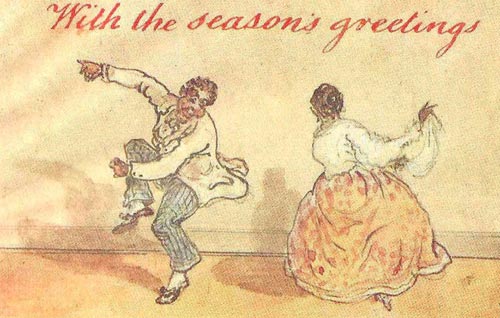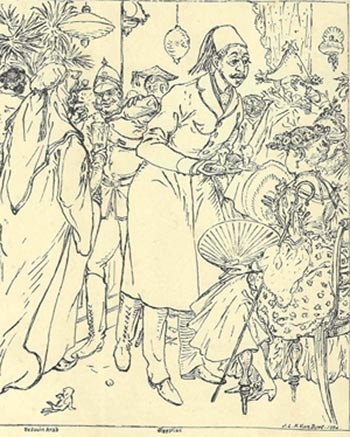A Christmas sketch among the many 19th century social events captured by J.L.K.

A Christmas card by Van Dort: A couple doing the " Kafferinha"
J.L.K. Van Dort who flourished in the latter half of the 19th century in Sri Lanka could well be described as the ‘Hogarth of Ceylon’. He was undoubtedly the best-known painter and illustrator working in the country at the time. From 1850 up till to his death in 1896, he recorded almost every social event of importance with his deft quick sketches, including religious festivals like Christmas.
Born on July 28, 1831, in Small Pass in the Fort of Colombo, his father – an architect, surveyor and artist of some fame is said to have had a hand in the design and supervision of the Governor’s residence – the Pavilion, in Kandy. It is likely Van Dort’s artistic education started at the school in Second Cross Street in the Pettah managed by Hippolyte Silvaf. Later he was a student at the Colombo Academy in the 1840s and would have been tutored by the Irish artist Andrew Nicholl.
Andrew Nicholl was sent out specifically from England to head the Academy’s department of design and art which he did from 1846-49. It is recorded that when Van Dort showed signs of promise as an artist in his school days the principal of the Colombo Academy, Dr. Barcroft Boake on seeing one of his drawings on the school’s walls had remarked “that fellow Van Dort is a genius and will someday set the lake on fire.
His career as an illustrator started in 1850 with drawings for The Young Ceylon and the Ceylon Observer. About the same time, he turned his attention to lithography and procured the necessary apparatus and material to set to work. By 1855 he had secured an appointment as a draughtsman at the Surveyor General’s office under Captain Gossett and had ample opportunities to use his varied talents in sketching and drawing.

1894: Egyptian Exile at the Governor's Residence (Queen's House) fancy dress Party
Among his best works – a series of pen and ink sketches of the equestrian events that took place annually at the Racecourse on the Galle Face Green just outside the Fort was executed about this time. These were finely worked sketches on small bits of paper about the size of his palm.
With the introduction of photography in the late 1840s, artists like Van Dort and Hippolyte Silvaf were commissioned to make colour enlargements of the daguerreotype type portraits of Colombo’s well-to-do society.
In January 1861 he married Cornelia Henrietta Spittel and they moved to a small dwelling in Hospital Street, Fort. About the same time, he worked on a commission – the album on The Costumes of Ceylon.
The ten illustrations in colour show the European especially Portuguese influence on the dress worn by urban Sri Lankans. This set of coloured drawings bound in one volume which bears the name plate J. Barnard Davis M.D. 1861 is at present deposited in the Department of National Museums, Colombo.
Between 1860 upto his death in 1898 his output was prolific. He was commissioned by several publishers of newspapers and periodicals both in Sri Lanka and abroad. He recorded almost every social event of importance – Royal visits, race meets, festivals, rural weddings, peraheras and pageants.
He also portrayed the Arabi Pasha, exiled from Egypt by the British authorities who was residing in Colombo. Recognized as the best illustrator of his day, Van Dort was appointed the local artistic correspondent to The Graphic,The Daily Graphic and Illustrated London News, for almost three decades. The Royal artist who accompanied the Duke of Edinburgh on his visit to Ceylon was so impressed by Van Dort’s sketches that he recommended him to the editors of other British journals. In 1870, three illustrations in the commemorative volume of the Royal visit titled The Duke of Edinburgh in Ceylon -A book of Elephant and Elk sport (1871) by John Capper was also done by him.
His excellent sketches appeared in A. M. Ferguson’s Souvenirs of Ceylon published in 1868. In the next three years several cartoons were published in the short-lived magazine Muniandi which was modelled on the satirical British magazine Punch.
Van Dort painted several murals for his friends including the series of rural scenes for James D’ Alvis’ s estate bungalow which was completed in 1867. In 1893 he was commissioned to execute eight large panels for the building housing the salon exhibits at the Chicago Fair held in the same year. These panels for the first time conveyed to the American public pictures of Sri Lanka’s pageants and other scenes.
An outstanding contribution in book illustration was the woodcut which appeared in John Capper’s publication Old Ceylon in 1877. These striking vignettes by Van Dort captured the vanishing mode of life of the Portuguese Burgher community in a period of rapid social change.
Van Dort’s interest was not confined to portraits, pageants and events; it included the recording of historic Dutch buildings and structures in Colombo. At the request of the Consul of Netherlands in Colombo, he made a fine collection of drawings: Reminiscence of the Dutch occupation of the island of Ceylon from sketches of Extinct remains of Forts, Buildings and Canals, inscriptions on tombstones etc., within or in the vicinity of the principal towns in Ceylon. These valuable drawings dated 1888- 89 are now in the possession of the Royal Institute of Linguistics and Anthropology, Leiden.
The last 20 years of his life was spent in quiet retirement in a house close to the sea at Bambalapitiya, that he named Dordrecht. He continued to work till his final days. He died on March 24, 1898, his obituary notice appearing in The Graphic the same year.
Searching for an ideal partner? Find your soul mate on Hitad.lk, Sri Lanka's favourite marriage proposals page. With Hitad.lk matrimonial advertisements you have access to thousands of ads from potential suitors who are looking for someone just like you.


